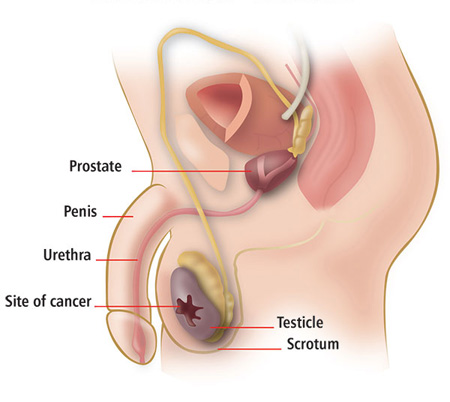The Scrotum: Anatomy and Purpose
The scrotum is a pouch-like structure located below the penis. It is composed of skin and muscle and contains a pair of testicles, which are responsible for sperm and testosterone production. The scrotum acts as a protective cover for these delicate organs.One crucial aspect of the scrotum is its unique ability to regulate the temperature of testicles. Sperm production requires a slightly lower temperature than that of the body, and the scrotum plays a significant role in maintaining this optimal environment. The contraction and relaxation of the muscles within the scrotum help adjust the distance between the testicles and the body, effectively controlling their temperature.

Functions of the Scrotum
The scrotum serves several vital functions that are fundamental to the male reproductive system.1. Sperm Production: The scrotum houses the testicles, where spermatogenesis occurs. Sperm production is an ongoing process, with the scrotum facilitating an optimal environment for the production, maturation, and storage of sperm cells.
2. Temperature Regulation: By constantly adjusting the position of the testicles in response to external factors such as temperature, the scrotum helps maintain the ideal environment for proper sperm development and maturation.
3. Protection: The scrotum acts as a natural protective shell for the testicles, safeguarding them from injuries or excessive pressure.
Scrotal Health and Care
To ensure optimal reproductive health, it is crucial to maintain good scrotal hygiene. Gentle washing with mild soap and warm water is typically sufficient. Regular self-examinations can help in detecting any abnormalities such as lumps, swelling, or changes in size or texture. In case of any concerns, it is always advisable to consult a healthcare professional for further evaluation and advice.
In conclusion, the scrotum is an essential anatomical structure in male reproductive biology. Its ability to regulate testicular temperature, along with serving as a protective enclosure for the testicles, highlights its significant contribution to overall male fertility and reproductive health.
By understanding the role and importance of the scrotum, individuals can better appreciate the intricate mechanisms involved in the male reproductive system. Remember, taking care of the scrotum is essential for maintaining lifelong reproductive well-being.Related FAQs about what is a scrotum
What is the function of the scrotum?
The scrotum serves multiple functions, including housing the testicles, regulating their temperature, and protecting them from injuries or excessive pressure.
How does the scrotum regulate testicular temperature?
The scrotum adjusts the distance between the testicles and the body through the contraction and relaxation of its muscles, helping to maintain the optimal temperature required for sperm production.
Why is temperature regulation important for sperm production?
Temperature regulation is crucial for proper sperm development and maturation. Sperm production requires a slightly lower temperature than that of the body, and the scrotum ensures this optimal environment for successful sperm production.
What are some signs of scrotal abnormalities to watch out for?
It is important to be aware of any abnormalities such as lumps, swelling, or changes in size or texture of the scrotum. Regular self-examinations and consulting a healthcare professional in case of concerns can help detect and address potential issues.
How to maintain good scrotal hygiene?
Gentle washing with mild soap and warm water is typically sufficient for maintaining good scrotal hygiene. It is important to keep the area clean and dry and to seek medical advice if any unusual symptoms or concerns arise.
Glossary about what is a scrotum
1. Scrotum: The scrotum is a pouch-like structure located below the penis and contains a pair of testicles, responsible for sperm and testosterone production. It acts as a protective cover and regulates temperature for optimal sperm development.
2. Testicles: The testicles, also known as testes, are male reproductive organs within the scrotum responsible for sperm and testosterone production.
3. Spermatogenesis: Spermatogenesis refers to the process of sperm cell production, maturation, and storage that occurs within the testicles.
4. Testosterone: Testosterone is the primary male sex hormone produced in the testicles and plays a crucial role in reproductive development, sexual function, and muscle mass maintenance.
5. Temperature Regulation: Temperature regulation refers to the scrotum's ability to adjust and maintain an optimal temperature for the testicles, facilitating proper sperm production and development.
6. Sperm Cells: Sperm cells, also known as spermatozoa, are male reproductive cells that are produced and stored within the testicles. They are vital for fertilizing the female egg during sexual reproduction.
7. Reproductive Health: Reproductive health encompasses the overall well-being and functionality of the male reproductive system, including the scrotum, testicles, and other associated structures.
8. Hygiene: Scrotal hygiene refers to the practice of keeping the scrotum clean and free from dirt or bacteria through regular washing with mild soap and warm water.
9. Self-Examinations: Self-examinations involve individuals inspecting their own scrotum and testicles to detect any abnormalities such as lumps, swelling, or changes in size or texture.
10. Male Fertility: Male fertility refers to the capacity of a male to successfully impregnate a female and father offspring. It relies on the proper functioning of the scrotum, testicles, and sperm production.
